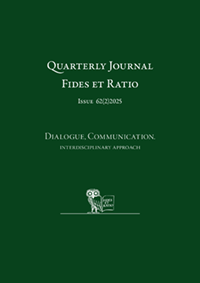Abstract
Introduction: During adolescence, relationships and communication within the family undergo significant changes, but they remain important, and a supportive family reduces the risk of mental health disorders in the future. However, caregivers – apart from engaging in various activities for the children’s development – also initiate fat talk, which refers to conversations that devalue the shape and weight of their own bodies and/or the bodies of others. This article addresses the potential connections between family fat talk conversations and body image, as well as the significance of these phenomena for the indirect self-destructiveness of both girls and boys in late adolescence. An exploratory study was designed using a correlational model, as the literature review indicates that these relationships – particularly in Poland – have not been empirically verified before, since the tool for assessing family fat talk conversations was only published in December 2024. Method: The study involved 83 individuals aged 18 and 19 – late adolescence. The following measurement tools were used: a) Personal Questionnaire – used to collect data characterizing the sample (e.g., age, gender, siblings), b) Body Esteem Scale for Adolescents and Adults (BESAA) in the Polish adaptation by Słowińska to measure body image, c) Family Fat Talk Questionnaire (FFTQ-PL) in the Polish adaptation by Ziółkowska et al. to measure body-related conversations within the family, d) Indirect Self-Destructiveness Scale (PAD-25) in the Polish adaptation by Pilarska and Suchańska to measure the intensity of risky behaviors. Results: The study confirmed that the greater the involvement in fat talk conversations within the family, the more negative self-perception and body image. It was shown that more intense participation in family fat talk conversations could be associated with a reduction of indirect self-destructiveness symptoms. Furthermore, higher frequency of family fat talk conversations is linked to a more negative self-image and a higher level of indirect self-destructive behaviors. Conclusions: Participation in family fat talk conversations may alleviate emotional tension related to dissatisfaction with one’s body, while temporarily protecting against more drastic forms of self-destructive behaviors. On the other hand, these conversations can also be considered a form of indirect self-destructive behavior due to their self-deprecating nature and the negative consequences that manifest over time. It is important to emphasize that further exploration of these areas and their co-occurrence is necessary to obtain more representative results.
References
Arroyo, A., Anderson, K.K. (2016). Appearance-related communication and body image outcomes: Fat talk and old talk among mothers and daughters. Journal of Family Communication, 16, 95–110. https://doi.org/10.1080/15267431.2016.1144604
Arroyo, A., Sergin, C., Harwood, J. (2014). Appearance-related communication mediates the link between self-objectification and health and well-being outcomes. Human Communication Research, 40(4), 463-482. https://doi.org/10.1111/HCRE.12036
Becker, C.B., Diedrichs, P.C., Jankowski, G., Werchan, C. (2013). I’m not just fat, I’m old: has the study of body image overlooked “old talk”? Journal of Eating Disorders, 1(6), 1-12. https://doi.org/10.1186/2050-2974-1-6
Berlin, J. (2023). Family Influences on Body Image: How Family Fat Talk Impacts How Women See Themselves (Doctoral dissertation, Roosevelt University).
Chow, C.M., Tan, C.C. (2018). The role of fat talk in eating pathology and depressive symptoms among mother-daughter dyads. Body Image, 24, 36-43. https://doi.org/10.1016/j.bodyim.2017.11.003
Dutkiewicz, A. (2019). Fat talk – mechanizmy i konsekwencje dewaluacji własnego wyglądu. Psychiatria i Psychologia Kliniczna, 18(2), 208-211. https://doi.org/10.15557/PiPK.2018.0025
Favazza, A.R. (1996). Bodies under siege: Self-mutilation and body modification in culture and psychiatry. The Johns Hopkins University Press.
Hooper, S.C., Kilpela, L.S., Ogubuike, V., Becker, C.B. (2023). Fat Talk, old talk, or both? Association of negative body talk with mental health, body dissatisfaction, and quality of life in men and women. Journal of Eating Disorders, 11(77), 1-17. https://doi.org/10.1186/s40337-023-00803-1
Katrevich, A., Register J., Aruguete M. (2014). The effects of negative body talk in an ethnically diverse sample of college students. North American Journal of Psychology, 16(1), 43-53.
Klayman-Farber, S. (2004). When the body is the target, self-harm, pain and traumatic attachments. Rowman Littlefield Publishers, Inc.
Kowalik, S. (2003). Ja-cielesne – Próba nowego spojrzenia. Polskie Forum Psychologiczne, 8, 1-2.
Kubacka-Jasiecka, D. (2021). Tatuaż i pirsing – wpływ wzorów kultury czy autoagresja? Sztuka Leczenia, 2, 47-60. (From:) https://www.sztukaleczenia.pl/pub/2021/2/SL-2-2021-5.pdf (access: 28.03.2025)
MacDonald, D.E., Dimitropoulos, G., Royal, S. (2015). The Family Fat Talk Questionnaire: Development and psychometric properties of measure of fat talk behaviors within family context. Body Image, 12, 44-52. https://doi.org/10.1016/j.bodyim.2014.10.001
Mills, J., Mort, O., Trawley, S. (2019). The impact of different responses to fat talk on body image and socioemotional outcomes. Body Image, 29, 149-155. https://doi.org/10.1016/j.bodyim.2019.03.009
Mills, J., Fuller-Tyszkiewicz, M. (2017). Fat talk and body image disturbance: A systematic review and meta-analysis. Psychology of Woman, 41, 1. https://doi.org/10.1177/0361684316675317
Mioduchowska-Zienkiewicz, A. (2015). Zachowania autoagresywne a obraz własnego ciała u kobiet z zaburzeniami odżywiania się. Studia Psychologica, 15(1), 45-62.
Mirucka, B. (2003). Ja–cielesne fundamentem osobowości. Polskie Forum Psychologiczne, 8(1-2), 30-40.
Pilarska, A., Suchańska, A. (2021). Skrócona wersja Skali Pośredniej Autodestruktywności PAD-25. Psychiatria Polska, 55(5), 1121-1137. https://doi.org/10.12740/PP/118006
Rogers, C.B., Martz, D.M., Webb, R.M., Galloway, A.T. (2017). Everyone else is doing it (I think): The power of perception in fat talk. Body Image, 20, 116-119. https://doi.org/10.1016/j.bodyim.2017.01.004
Słowińska, A. (2019). Skala Samooceny Ciała dla Adolescentów i Dorosłych (BESAA) – polska adaptacja metody. Polish Journal of Applied Psychology, 17(1), 21-31.
Suchańska, A. (1998). Przejawy i uwarunkowania psychologiczne pośredniej autodestruktywności. Wydawnictwo UAM.
Suchańska, A., Wycisk, J. (1998). Pośrednia autodestruktywność i jej związki z poczuciem wewnętrznej spójności. Czasopismo Psychologiczne, 4(2), 128-135.
Teleon, A., Włoszczak-Szubzda, A. (2019). Zdrowie psychiczne dzieci i młodzieży w Polsce a rola rodziny. Medycyna Ogólna i Nauki o Zdrowiu, 25(1), 6-11. https://doi.org/10.26444/monz/103096
Tsirigotis, K. (2021). Emotional Intelligence, indirect self-destructiveness and gender. Psychiatria & Psychologia Kliniczna, 21(3), 219-225. https://doi.org/10.15557/PiPK.2021.0024
Turner, S. (1996). The Body and Society: Explorations in Social Theory. Sage.
Ziółkowska, B., Łoboda, D., Dąbrowska A., Szrajda, J. (2024). Family Fat Talk Questionnaire – adaptacja polska. Psychiatria Polska, 339, 1-14. https://doi.org/10.12740/PP/OnlineFirst/175149

This work is licensed under a Creative Commons Attribution-NonCommercial-NoDerivatives 4.0 International License.
Copyright (c) 2025 Quarterly Journal Fides et Ratio

